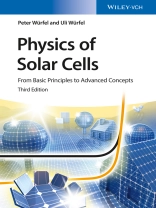The new edition of this highly regarded textbook provides a detailed overview of the most important characterization techniques for solar cells and a discussion of their advantages and disadvantages.
It describes in detail all aspects of solar cell function, the physics behind every single step, as well as all the issues to be considered when improving solar cells and their efficiency. The text is now complete with examples of how the appropriate characterization techniques enable the distinction between several potential limitation factors, describing how quantities that have been introduced theoretically in earlier chapters become experimentally accessible.
With exercises after each chapter to reinforce the newly acquired knowledge and requiring no more than standard physics knowledge, this book enables students and professionals to understand the factors driving conversion efficiency and to apply this to their own solar cell development.
قائمة المحتويات
List of Symbols ix
Preface xi
1 Problems of the Energy Economy 1
1.1 Energy Economy 1
1.2 Estimate of the Maximum Reserves of Fossil Energy 4
1.3 The Greenhouse Effect 6
1.3.1 Combustion 6
1.3.2 The Temperature of the Earth 7
1.4 Problems 9
2 Photons 11
2.1 Black-body Radiation 11
2.1.1 Photon Density nγ in a Cavity (Planck’s Law of Radiation) 12
2.1.2 Energy Current Through an Area dA into the Solid Angle dΩ 16
2.1.3 Radiation from a Spherical Surface into the Solid Angle dΩ 19
2.1.4 Radiation from a Surface Element into a Hemisphere (Stefan–Boltzmann Radiation Law) 20
2.2 Kirchhoff’s Law of Radiation for Nonblack Bodies 22
2.2.1 Absorption by Semiconductors 24
2.3 The Solar Spectrum 24
2.3.1 Air Mass 26
2.4 Concentration of the Solar Radiation 28
2.4.1 The Abbé Sine Condition 29
2.4.2 Geometrical Optics 30
2.4.3 Concentration of Radiation Using the Sine Condition 31
2.5 Maximum Efficiency of Solar Energy Conversion 33
2.6 Problems 39
3 Semiconductors 41
3.1 Electrons in Semiconductors 42
3.1.1 Distribution Function for Electrons 43
3.1.2 Density of States De(εe) for Electrons 43
3.1.3 Density of Electrons 48
3.2 Holes 50
3.3 Doping 52
3.4 Quasi-Fermi Distributions 57
3.4.1 Fermi Energy and Electrochemical Potential 59
3.4.2 Work Function 63
3.5 Generation of Electrons and Holes 65
3.5.1 Absorption of Photons 65
3.5.2 Generation of Electron–Hole Pairs 69
3.6 Recombination of Electrons and Holes 71
3.6.1 Radiative Recombination, Emission of Photons 72
3.6.2 Nonradiative Recombination 74
3.6.3 Lifetimes 85
3.7 Light Emission by Semiconductors 87
3.7.1 Transition Rates and Absorption Coefficient 88
3.8 Problems 92
4 Conversion of Thermal Radiation into Chemical Energy 95
4.1 Maximum Efficiency for the Production of Chemical Energy 98
4.2 Shockley–Queisser Limit 103
4.3 Problems 104
5 Conversion of Chemical Energy into Electrical Energy 105
5.1 Transport of Electrons and Holes 105
5.1.1 Field Current 106
5.1.2 Diffusion Current 107
5.1.3 Total Charge Current 109
5.2 Separation of Electrons and Holes 111
5.3 Diffusion Length of Minority Carriers 113
5.4 Dielectric Relaxation 115
5.5 Ambipolar Diffusion 116
5.6 Dember Effect 117
5.7 Mathematical Description 120
5.8 Problems 120
6 Basic Structure of Solar Cells 123
6.1 A Chemical Solar Cell 123
6.2 Basic Mechanisms in Solar Cells 128
6.3 Dye Solar Cell 131
6.4 The pn-Junction 133
6.4.1 Electrochemical Equilibrium of Electrons in a pn-Junction in the Dark 133
6.4.2 Potential Distribution across a pn-Junction 134
6.4.3 Current–Voltage Characteristic of the pn-Junction 138
6.5 pn-Junction with Impurity Recombination, Two-Diode Model 143
6.6 Heterojunctions 147
6.7 Semiconductor–Metal Contact 150
6.7.1 Schottky Contact 152
6.7.2 MIS Contact 153
6.8 The Role of the Electric Field in Solar Cells 154
6.9 Organic Solar Cells 160
6.9.1 Excitons 160
6.9.2 Structure of Organic Solar Cells 163
6.10 Light Emitting Diodes (LED) 167
6.11 Problems 169
7 Limitations on Energy Conversion in Solar Cells 171
7.1 Maximum Efficiency of Solar Cells 171
7.2 Efficiency of Solar Cells as a Function of Their Energy Gap 174
7.3 The Optimal Silicon Solar Cell 175
7.3.1 Light Trapping 176
7.4 Thin-film Solar Cells 181
7.4.1 Minimal Thickness of a Solar Cell 182
7.5 Equivalent Circuit 183
7.6 Temperature Dependence of the Open-circuit Voltage 185
7.7 Intensity Dependence of the Efficiency 186
7.8 Efficiencies of the Individual Energy Conversion Processes 186
7.9 Problems 188
8 Concepts for Improving the Efficiency of Solar Cells 189
8.1 Tandem Cells 189
8.1.1 The Electrical Interconnection of Tandem Cells 193
8.2 Concentrator Cells 194
8.3 Thermophotovoltaic Energy Conversion 196
8.4 Impact Ionization 197
8.4.1 Hot Electrons from Impact Ionization 200
8.4.2 Energy Conversion with Hot Electrons and Holes 200
8.5 Two-step Excitation in Three-level Systems 203
8.5.1 Impurity Photovoltaic Effect 203
8.5.2 Up- and Down-conversion of Photons 208
8.6 Problems 211
9 Characterization of Solar Cells 213
9.1 Spectral Response and Quantum Efficiency 213
9.2 Quasi-Steady-State Photoconductance 218
9.3 Luminescence 220
9.3.1 Homogeneous Distribution of Electrons and Holes 221
9.3.2 Inhomogeneous Distribution of Electrons and Holes 222
9.3.3 Electroluminescence 223
9.3.4 Photoluminescence 224
9.3.5 Diffusion Length 225
9.3.6 Series Resistance 228
9.4 Thermography 229
9.5 Light-Beam-Induced Current (LBIC) 230
9.6 The Suns-VOC Method 233
9.7 Transient Techniques 237
9.7.1 Photovoltage Decay 237
9.7.2 Transient Absorption 238
9.7.3 Charge Carrier Extraction 240
9.7.4 CELIV – Charge Extraction by Linearly Increasing Voltage 241
9.7.5 Impedance Spectroscopy 241
Solutions 245
Appendix 263
References 267
Index 271
عن المؤلف
Peter Wurfel studied physics at the University of Karlsruhe where he later became Professor. His research activities started with ferroelectric thin films, mostly for pyroelectric infrared detectors. He has a keen interest in the physics of photovoltaics and has more than 25 years research and teaching experience in this field.
Uli Wurfel studied physics at the Universities of Freiburg and Heidelberg. He received a Ph D from the University of Freiburg in 2006. Since 2009 he is head of the group ‘dye and organic solar cells’ at the Fraunhofer Institute for Solar Energy Systems (ISE) in Freiburg. Besides an ambition to realize low-cost organic solar cells, he is also highly interested in selective contacts and modelling solar cells.












